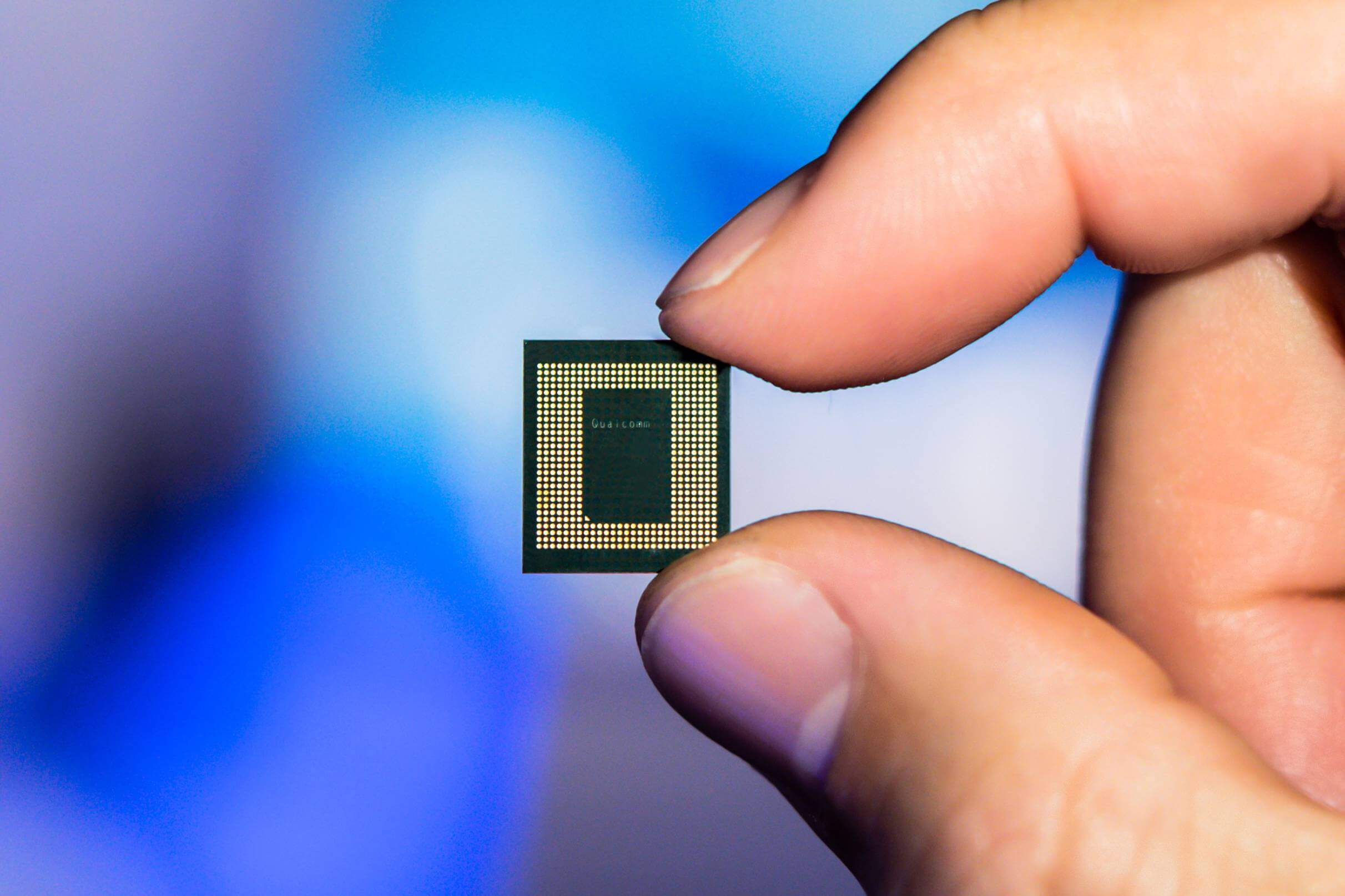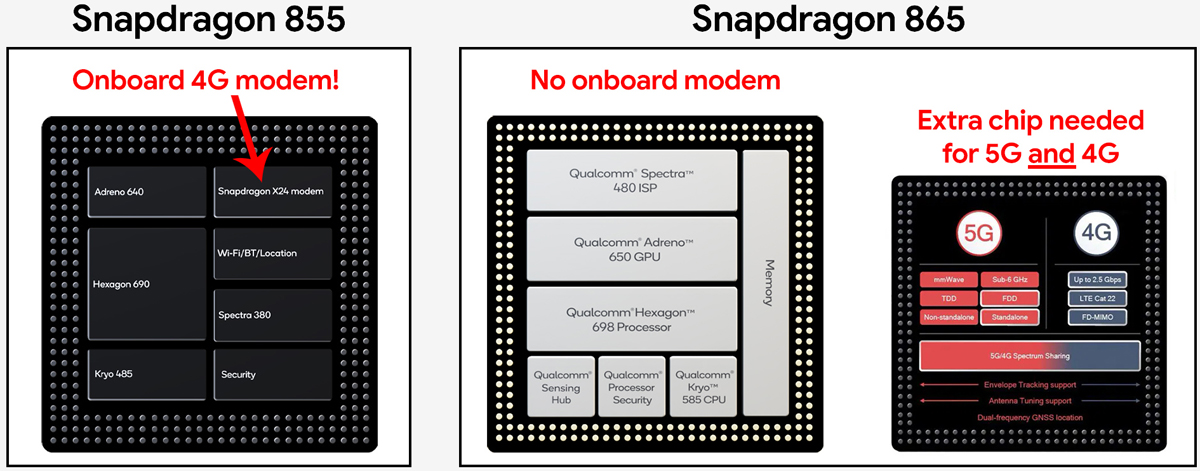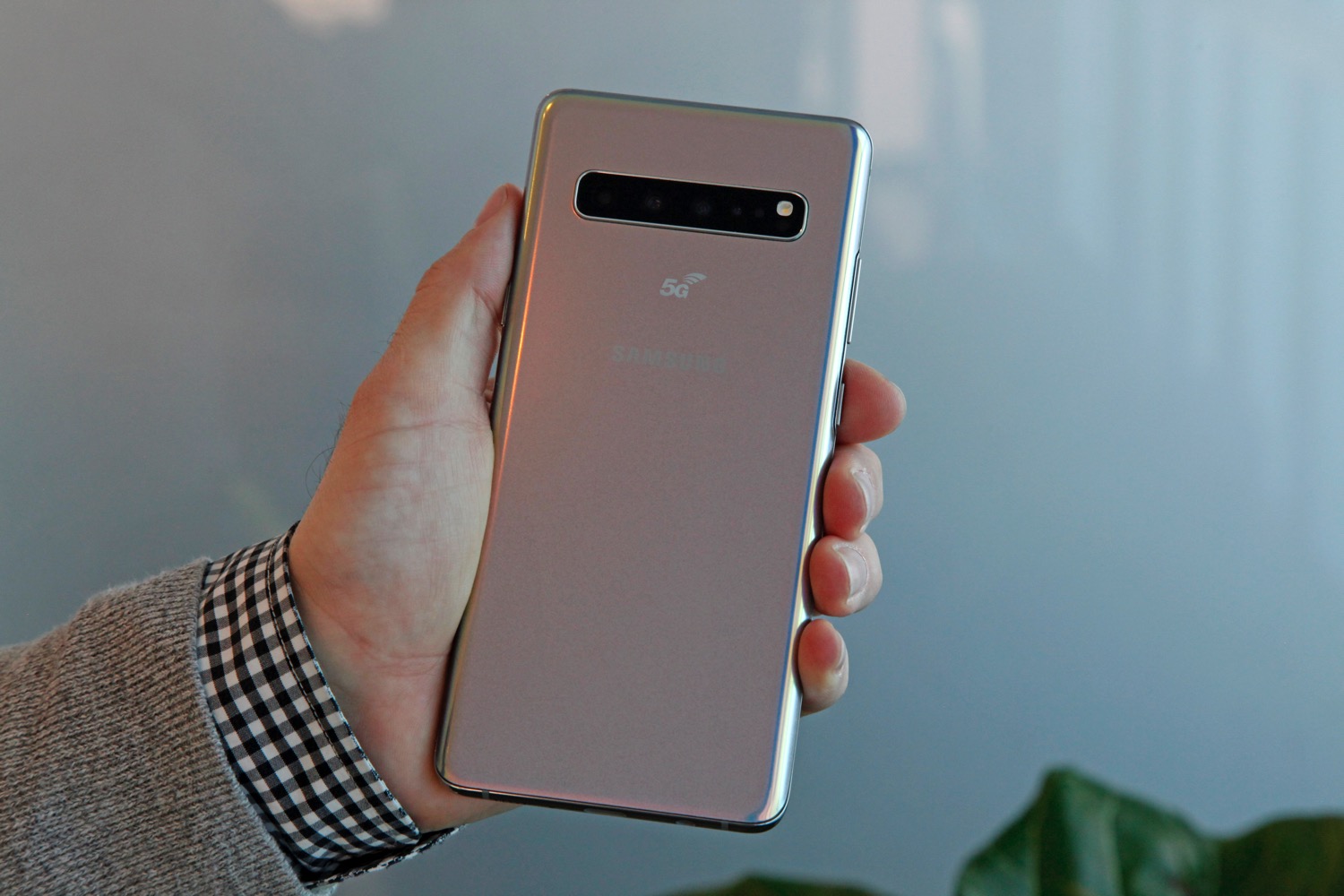11 days ago, at AnandTech:
5G and Modem Integration
IC: Current 8cx solutions rely on external 5G modems (external to the main SoC) in order to support 5G connectivity. We’re still in a 4G/5G transition phase – would you expect an integrated 5G SoC/modem as a single piece of silicon in this sort of form factor?
AK: Absolutely. If you go back to the 4G days when it was launched, we took all of the 3GPP specifications for 4G that were defined and we put it in a bit of silicon. Over the course of a couple of years, you hone in on the features and the functionality that are most useful – you figure out different partitioning and architectures for your modem to make it smaller, and then that gets moved onto the main SoC. That’s exactly what is going to happen with 5G as well. As you’ve already heard, we are going to have integrated 5G SoCs coming in 2020. The life of a standard mobile PC is in the region of 2-3 years, and you’re not going to have a new mobile SoC every year, so the next generation after 8cx is where you should look for an integrated solution.
IC: We currently have a bifurcated strategy with 4G and 5G, given that some markets have been quicker to adopt different parts of the 5G standards than others. Is that strategy of separating 4G and 5G silicon expected to continue long term, or will there be a right time to go for a single integrated 5G philosophy across the board?
AK: I think the good part right now is that we have a line, a product line of devices that span our entire portfolio. In PC devices, we have the 8cx at the top, but we also have a version of the 8cx called the 8c. It will be a little less powerful, but it targets parts of our line-up in-between the 8cx and the 850. And there’s another one coming, so you will have a whole line-up – some of them 4G, some of them 5G.
IC: Is the smartphone market ready for 5G in the mid-range?
CA: Yes. You have to look at all the stakeholders and why we’re so focused on scaling right now. There are three parts to this answer
.
First, think from the operator’s perspective. It’s very clear, you can argue, that you can have a conversation about how fast you are going to build coverage, how fast we are reforming the spectrum, but the trends are very clear: users are using more data, and the average data consumption per month is going up. If you look at 5G in Korea, there are 2 million subscribers, and the data from KT (Korea Telecom) is that average data per user has doubled. So from the operator perspective, you’re going to get to a point where it is uneconomical to give unlimited data plans on 4G, and there is a need to switch for 5G, as 5G offers you a lower cost per bit and gives the user to have a premium experience with less congestion. Operators want to move you onto 5G for a variety of reasons, but that one is key from a user experience perspective
.
IC: We’ve seen a few operators show resistance to providing affordable 5G plans. From my perspective, aside from the cost of current devices, that’s somewhat of a limiting factor.
CA: Depending on the market there may be some segmentation of price plans, and I think that network slicing is going to enable this. I feel that every new technology that hits the market is expected to have a price premium for that extra performance. But overall, the economics, from the operator perspective, there’s one element on the revenue side and that’s how it is priced to the consumers. But in terms of operating costs, 5G brings about a different cost equation. Especially if you can build out knowing how the customers will use data in the future.
It’s hard for me to say what the operators will exactly do, but I’ll tell you that we’re still at an initial scale-out. The thing is, having worked at an operator, it’s all about transitions from one generation of technology to the next. At the beginning of those transitions, you have a non-ideal situation, based on hardware and deployment. Even in Europe today, we still have operators with 2G. As operators have migrated from 2G to 3G then to 4G, you have to adjust that cost equation, paying maintenance, electricity, paying all those things, and in the beginning of a transition, you have to run multiple networks, and then by getting people on board helps smooth the deployment out to future sites. So I think you’re going to see the equation of the economics being amortised as more users sign up, along with CapEx (capital expenditure) and OpEx (operational expenditure). How they do that deployment, in a transition phase, depends on the technology, but ultimately it’s a drive to a lower cost per bit. 5G is designed for this, and the data usage model will change: customers might not have a fixed line into the home in the more, and use 5G for that last mile of cable. This is why scale is so important.
For part two of the question ‘is the smartphone market ready for 5G in the mid-range’, we should consider that we now have a very mature smartphone market. In a mature smartphone market like the United States, the number of people with at least a ‘good’ device is high, and people buy knew phones every 2.5-3 years. In Europe it’s more 3-4 years. So if you’re going to buy a phone right now, and you already know about 5G and heard that 5G is coming, you can end up with a device for 2-3 years that won’t support the fastest speeds or get the best user experience. Users who know about 5G will want a 5G phone with how fast 5G is being supported.
The third part of my answer is that the device ecosystem is mature ahead of the network: the devices are ready and the network is catching up. Unlike the transitions to 3G and to 4G, where the operators were first, here at Qualcomm we have been accelerating and driving the device adoption of 5G. So even if you never use the 5G modem in the device, it’s still a very competitive unit, such as the Samsung Galaxy S10 5G, from the industrial design, battery life, and all these things. With the device ecosystem being ready, the operators are getting there, and with more phones enabling 5G today, users aren’t going to want to be stuck on a 4G smartphone.
The last piece that you don’t see right away with one of these new devices is the 5G – there is a bigger difference between premium and the mid-range here. If I have a Samsung high tier device, or even a mid-tier device, and then I go buy the premium tier, what I will see is the premier tiere has a better camera, a higher end display, maybe a bigger screen with more screen area, more memory, better graphics, and the games probably play a little better. The services on both devices are still kind of the same – I still have WhatsApp, I still have Instagram. Some might perform better, some might be worse. With 5G, it’s all a little different. When it comes to the question of say, streaming 4K video, it’s a very binary result: you either have it or you don’t. If I want to stream some games, you either can or you cannot. It’s a very binary proposition. The evolution of social media with live broadcasting, such as Facebook Live, means that the entire developer ecosystem says that if the capabilities are there, users want to have it.
When you put all of this together, you get to the same conclusion that we got to, and I think that forms the key basis of our announcements this year. Mission one has been to get 5G launched, and get all the flagships supporting 5G. We have our flagship modem, and we have our second generation 5G that we will show at our Tech Summit later this year, and we’re going to impress you! But then that still isn’t enough – we need to scale 5G, and we need to scale it right now. The transition is going to be faster than we’ve seen with 4G, and that’s why you’ll see our 7-series and 6-series with 5G and we’ll keep going.
IC: Currently we’re seeing a mix of discrete 5G solutions and integrated 5G solutions, whether it’s in a smartphone or other devices. There has been some commentary regarding performance in both methods, such that some discrete options can offer 2x the bandwidth of an integrated solution. What is Qualcomm’s approach here?
CA: You have to think about 5G a little differently to 4G. I won’t comment on our competitors, as they’ll do what they want to do, but I can tell you that 5G gives you the flexibility to have differences in the performance as you design the modem. Despite this, there is one very important thing on 5G is average speed – if you remember when Qualcomm pioneered Gigabit LTE or even 2 Gigabit LTE, you had a significant improvement in peak speeds, but the average speeds don’t improve at the same rate. It’s very different with 5G – with 5G the average data rates go up and, what you’re going to see as we start moving our modems onto our 7-series chipsets is that we’re not going to compromise, average data rates aren’t going to be compromised, and latencies aren’t going to be compromised. You can still have different choices, as you’ll see from our portfolio, we’ll still have full support for millimeter wave, and full support for Sub 6 GHz. We are going to unveil all the details of our modem in the 7-series chipsets at our Tech Summit. But we have a plan, and you’ll see a pattern.
Essentially, this new chip is being replaced next year:
("As you’ve already heard, we are going to have integrated 5G SoCs coming in 2020.")



